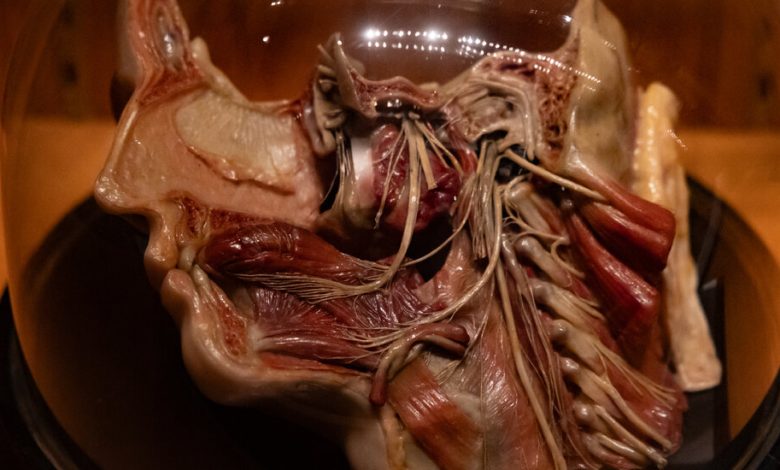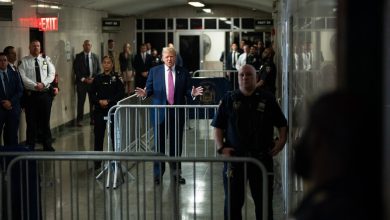A Museum of ‘Electrifying Frankness’ Weighs Dialing It Down

The Mütter Museum, a 19th-century repository of medical oddments and arcana at the College of Physicians of Philadelphia, attracts as many as 160,000 visitors a year. Among the anatomical and pathological specimens exhibited are skulls corroded by syphilis; spines twisted by rickets; skeletons deformed by corsets; microcephalic fetuses; a two-headed baby; a bound foot from China; an ovarian cyst the size of a Jack Russell terrier; Grover Cleveland’s jaw tumor; the liver that joined the original “Siamese twins,” Cheng and Eng Bunker; and the pickled corpse of the Soap Lady, whose fatty tissues decomposed into a congealed asphalt-colored substance called adipocere.
“People are just intrinsically more interested in the unusual,” said Dean Richardson, a professor of equine surgery at the University of Pennsylvania School of Veterinary Medicine’s New Bolton Center. “Who could look at a two-headed calf without wanting to know how that happened? Biology is a marvel and better understood if you recognize that its complexities must inevitably lead to some ‘errors.’”
The celebrity magician Teller, a Philadelphia native, called the Mütter a place of electrifying frankness. “We are permitted to confront real, not simulated, artifacts of human suffering, and are, at a gut level, able to appreciate the epic achievements of medicine,” he said.
But, like museums everywhere, the Mütter is reassessing what it has and why it has it. Recently, the institution enlisted a public-relations consultant with expertise in crisis management to contain criticism from within and without.
The problems began in February when devoted fans of the Mütter’s website and YouTube channel noticed that all but 12 of the museum’s 450 or so images and videos had been removed. (In one jokey video, staff members pretended to brush the teeth of skulls; in another, they feigned drinking from one.) Rumors quickly circulated, and three months later Kate Quinn, who was hired last September as the Mütter’s executive director, posted an explanation. The clips, which had amassed more than 13 million views, were being re-evaluated, she wrote, “to improve the visitor experience.”
Ms. Quinn had tasked 13 unnamed people — medical historians, bioethicists, disability advocates, members of the community — with providing feedback on the digital collection. “Folks from a wide background,” Ms. Quinn said in an interview. The purpose of what she called the Mütter’s “post-mortem,” set to finish by Labor Day, was to ensure that the online presence of the museum was appropriate and that its 6,500 specimens of human remains on display were being treated respectfully.
Blowback to Ms. Quinn’s ethical review was ferocious. An online petition garnered the signatures of nearly 33,000 Mütter enthusiasts who insisted that they loved the museum and its websites as they were. The petition criticized Ms. Quinn and her boss, Dr. Mira Irons, the president and chief executive of the College of Physicians, for decisions predicated on “outright disdain of the museum.” The complaint called for the reinstatement of all web content and urged the college’s board of trustees to fire the two women immediately. (To date, about one-quarter of the videos have been reinstated.)
Moreover, in June, The Wall Street Journal ran an opinion piece entitled “Cancel Culture Comes for Philly’s Weirdest Museum,” in which Stanley Goldfarb, a former director of the college, wrote that the museum’s new “woke leaders” appeared eager to cleanse the institution of anything uncomfortable. Robert Hicks, director of the Mütter from 2008 to 2019, voiced similar sentiments this spring when he quit as a museum consultant. His embittered resignation letter, which he released to the press, stated that Dr. Irons “has said before staff that she ‘can’t stand to walk through the museum,’” and it advised the trustees to investigate her and Ms. Quinn, both of whom Dr. Hicks believed held “elitist and exclusionary” views of the Mütter.
Neither Dr. Goldfarb nor Dr. Hicks had tried to reach out to Ms. Quinn or Dr. Irons to discuss their concerns directly.
Amid the professional grumbling, 13 employees left and panicky rumors surfaced on social media: that Dr. Irons planned to turn the Mütter into a research museum closed to the public; that Ms. Quinn had been quietly removing “permanent” exhibits featuring malformed fetuses; that administrators wanted to deter “freaky Goths” and subvert the organization’s mission, which is to help the public “understand the mysteries and beauty of the human body and to appreciate the history of diagnosis and treatment of disease.”
In an email, Dr. Irons insisted that the hearsay was just that. “I categorically deny any intention, as Dr. Hicks asserts, that I hate the museum or that my purpose is anything other than to ensure that the materials we display meet professional standards and serve the mission of the college and the museum,” she wrote. “In my view, much of this controversy is being fueled by resistance to any changes in the status quo to the point where we can’t even engage in a discussion without triggering recriminations and accusations.”
The museum was established in 1859 by Thomas Dent Mütter, a surgery professor, as a teaching tool to show doctors-to-be what they might encounter. Dr. Mütter, who was the first surgeon in Philadelphia to use ether anesthesia, endowed the museum with $30,000 and a trove of 1,700 anatomical oddities and medical curiosa that he had used in his classes.
The collection expanded by subsequent donations and acquisitions, some of which, such as the saponified corpse of Soap Lady, were obtained through subterfuge and bribes to grave diggers. In an age before medical consent was codified, the unclaimed corpses of inmates, paupers, suicide victims and Native Americans were often made available to medical schools as cadavers for dissection and anatomy lessons.
The Mütter opened to the public in 1863 and was initially intended only for “medical practitioners”; by the 1970s it was drawing 5,000 visitors annually. “Many people have their first interest in something because it’s weird or edgy or titillating, but that sometimes leads to investigation of more substantive matters,” Dr. Richardson said. “I’d wager there have been plenty of young people whose first impetus to think about the human body was provided by the Mütter.”
In 1986, Gretchen Worden, who was then the curator, had the Mütter renovated in the theatrical aesthetic of a Victorian-era cabinet of curiosities, with red carpets and red velvet drapes. “The displays are jarring reminders of mortality, proof that a human being is truly no more than a sum of its parts,” she said at the time. She increased attendance with a popular if somewhat ghoulish museum calendar and mischievous appearances on “Late Night With David Letterman” in which she menaced the host with lobotomy picks and tonsil guillotines and grossed him out with hairballs and human horns.
Dr. Worden’s antics were considered undignified by some trustees and counter to the health-oriented image they wanted to encourage, but she prevailed. Almost one-third of the college’s revenue now derives from the Mütter’s admissions, store and library services.
But museums that display human remains increasingly face public reckoning and scrutiny. Some museums have scrapped the term “mummy” to describe preserved corpses from ancient Egypt, deeming it dehumanizing. In 2021, Jo Anderson, a curator at Great North Museum in Newcastle, England, said, “A significant number of visitors question whether mummified people on display are real.”
“What was respectful 100 years ago, or even five years ago, may not be so today,” Dr. Irons said. At the Mütter, she said, the challenge is to make visitors see damaged body parts for what they really are — not objects or curiosities, but real humans who were once alive.
Dr. Irons, a physician who treats children with rare genetic diseases, acknowledged that she had difficulty viewing certain exhibits, particularly fetal specimens presented as medical novelties. She wants such displays to provide a fuller picture of the individual, the condition in question and the therapeutic advances that would affect today’s afflicted.
Ms. Quinn was hired after a dozen years as director of exhibitions and public programs at the Penn Museum in Philadelphia. “I see my role as getting us back to what we were prior to taking that left-hand turn with regard to the mission,” she said, referring to the era of Dr. Worden. “We’re actively moving away from any possible perception of spectacle, oddities or disrespect for the collections in our care.”
On arriving, Ms. Quinn was surprised to learn that the Mütter had no ethics policy, let alone a human-remains policy. What’s more, the museum had only fragmentary data about how many residents — as the staff refers to the human specimens — came to the Mütter or the circumstances of their lives. “We owe it to the remains to learn as much as we can about each individual who’s here,” Ms. Quinn said. “And yes, it matters to a lot of people.”
The museum has arranged to return the remains of seven Native Americans to communities in New Jersey and California, as required by federal law. Ms. Quinn is trying to keep ahead of the rapidly changing legal and ethical landscape by conducting the first comprehensive audit of the museum’s objects since the 1940s. She expects this process to take at least four years to complete given the record-keeping and the complexities of the Mütter’s 35,000-object collection, most of which is in storage in the basement.
Dr. Hicks remains unhappy with the new perspective. “Dr. Mütter would have been confused at the dictum that the museum should be about health, not death,” he lamented in his resignation letter. “The principle emblazoned at the entrance of many anatomy theaters, ‘This is where the dead serve the living,’ is readily understood by museum visitors without special guidance by Dr. Irons.”
Ms. Quinn said: “Robert Hicks? Someone once said, ‘Some people cause happiness wherever they go; others whenever they go.’”



